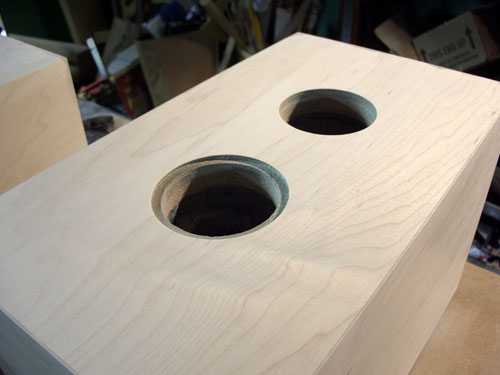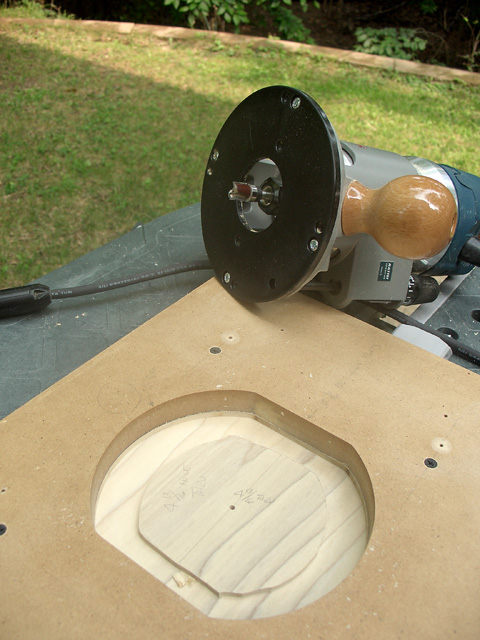
Trimming Veneer from Enclosure Openings and Flange Recesses
I've veneered over openings for port tubes and terminal cups. Although I haven't done it yet, it's quite common to veneer over driver openings in baffles too. Of course, the veneer material needs to be removed from these openings.
A common question on the speaker building forums is how to remove the veneer from the openings, and leave a clean edge around the periphery. The steps below all use a router to do the work.
Trimming through holes
The simplest case to deal with is a through-hole with no flange.
I start by using an Exacto knife to cut a rough opening in the center that is
large enough to insert a flush trim router bit (the kind of router bit with a
bearing at the bottom). Once the bit is inserted in the rough opening, start the
router and make shallow cuts spiraling outward until the bearing rides against
the side of the hole. When spiraling outward, be sure that the router bit
is rotating against the direction of cut.
This is extremely fast and easy to do.

Use a flush trim bit to cut veneer flush to the hole opening. I do this at the same time I flush-trim the edges of a newly-glued piece of veneer.
Cut rough openings large enough to insert the router bit.
Spiral outward until the bit is flush against the hole in the enclosure. The bit rotation is clearly marked on my Bosch 1617EVSPK router and the router bit should rotate into new material when cutting.
Cutting flange recesses #1
For all the methods that follow, I begin by cutting away most of the opening
using the flush trim bit shown above. This leaves only the material
covering the recesses.
Cutting the remaining veneer from the flange recess is a little trickier, but with the right tools, it's
fairly straightforward. I've used a rabbeting bit to cut the veneer away from a
flange recess, although you'll often find that the available bearing diameters
won't exactly space the cutter the way you want. You are a lucky individual if
the rabbeting bit kit has exactly what you need.

A rabbeting bit has interchangeable ball bearings to space the cut at different offsets. You'll find that seldom do the steps match with the depth you need. Shim the bearing with electrical tape to bridge the steps.
A little electrical tape can shim the bearing enough to get the job done if the right sized bearing isn't available. The bearing shouldn't spin much once contact is made with the side of the through-hole so balance isn't an issue. It may look crude, but it works.
Each wrap of Scotch Super 33+ electrical tape around the bearing O.D. reduces the depth of rabbet by 0.007". I start with more wraps than I need, then unwind the wraps of tape until the veneer is trimmed exactly flush with the recess wall.
Once again, make sure the router bit is spinning against the direction of cut.
Cutting flange recesses #2
Shown below is another method that was suggested in the
HT Guide forum, but I
haven't tried it yet. Sounds reasonable, and it should work for very
shallow recesses if the tip of the flush trim bit is ground down sufficiently.

This looks to be a promising way to trim very shallow recesses.
Because grinding carbide can be difficult, there are some companies that make bits already shortened. Search for "dado trim" bits like one found on these pages: http://www.holbren.com/flush-bevel-trim-solid-carbide, or item number 124-0442 from http://www.eagleamerica.com/product/v124-0412/ea_-_laminate_trim, or listed as a non-stock item from Woodcraft.
Cutting flange recesses #3
The final method offered here is
to use a pattern to control the cut. A pattern can be made using a Jasper circle
guide (or equivalent), and clamped to the enclosure for cutting. You'll need a
short pattern bit (i.e. the 1/2" long
MLCS Katana #16509) to cut or trim veneer from the recess.
One potential problem with this approach is centering the pattern accurately over the enclosure opening. I haven't given that much thought, but there may be an easy solution.
Pattern bits have ball bearings mounted at the top of the cutter. A bearing rides against the shape of the pattern and replicates it into the material clamped beneath.
Below is a picture showing a pattern in use. While this picture shows the cutting of a flange recess for a Peerless driver into solid wood, the same procedure is used to trim away veneer.

Bill Schneider
December 25, 2008